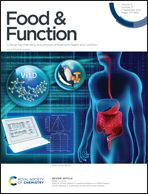Relationship between the n-3 index, serum metabolites and breast cancer risk
Abstract
The present study aimed to investigate the relationship between the n-3 index, serum metabolites and breast cancer risk. A total of 104 newly diagnosed breast cancer patients and 70 healthy controls were recruited. The erythrocyte phospholipid fatty acid composition was determined by gas–liquid chromatography, and the n-3 index was calculated with the percentage of eicosapentaenoic acid plus docosahexaenoic acid in total fatty acids. Serum metabolomic profiles were analyzed by UHPLC-Q-Exactive Orbitrap/MS. The results showed that the erythrocyte phospholipid n-3 index was significantly lower in breast cancer patients than in healthy controls, and it was inversely associated with breast cancer risk (OR = 0.60; 95% CI: 0.36–0.84). Metabolomics analyses showed that serum 16α-hydroxy dehydroepiandrosterone (DHEA) 3-sulfate, lysophatidylethanolamines (LPE) 22:0/0:0 and hexanoylcarnitine were significantly higher, while thromboxane B3, prostaglandin E3 (PGE3) and 18β-glycyrrhetinic acid were significantly lower in breast cancer patients than those in healthy controls. In addition, serum 16α-hydroxy DHEA 3-sulfate was inversely correlated with the n-3 index (r = −0.412, p = 0.036). In conclusion, our findings suggest that the lack of n-3 PUFAs might be a potential risk factor for breast cancer, and the serum metabolite 16α-hydroxy DHEA 3-sulfate may play an important role in linking n-3 PUFA deficiency and breast disease etiology.



 Please wait while we load your content...
Please wait while we load your content...